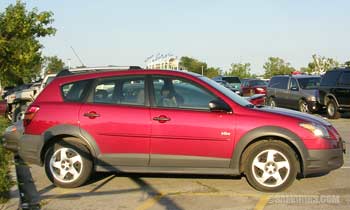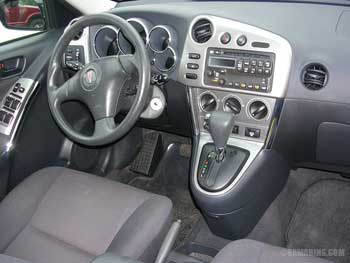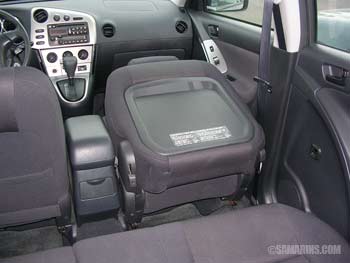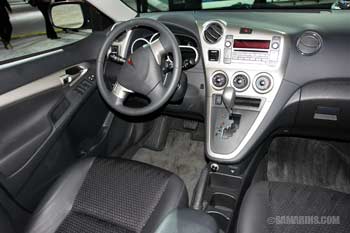Buying Pontiac Vibe: pros and cons, common problems
Updated: July 18, 2022
One of the last cars of the iconic Pontiac brand, the Vibe, was introduced in 2002 as a 2003 model. It's a product of joint venture between General Motors and Toyota.
The Vibe is mechanically similar to the Toyota Matrix; it rides on the Toyota Corolla platform and is powered by a Toyota engine. The Vibe is available as front- or all-wheel drive.The Vibe's tall roof line and upright driver's seat offer good headroom for tall drivers and excellent front visibility. The rear seat folds flat for extra cargo space. The front passenger seatback folds forward for extra long items. In the 2003-2008 Vibe, the liftgate glass opens separately. All in all, it's a rare practical, fuel efficient vehicle that is also happened to be the most reliable car in the GM's lineup. The 1.8L engine is a better choice in our view. For 2009 the Vibe has been redesigned, but discontinued after the 2010 model year. What are the pros and cons and problems that owners report?
Pros:
- The risk of expensive repairs is small. Even if the engine or transmission will need to be replaced, used units are not too expensive.
- Good on gas.
- The Vibe is dependable and will not cost a lot to maintain or repair. Tires are not too expensive to replace.
- Easy to work on.
- Comfortable driving experience, unique sporty rugged style, good front visibility, plenty of headroom.
- Cargo space is comparable to that of some SUVs, flat cargo floor.
- Discontinued, some parts are difficult to find.
- As any tall car, the Vibe is sensitive to strong side winds.
- Blind spots in the back.
- The A/C is not very strong.
- The 1.8L engine feels underpowered with full load.
An alternator can fail causing the battery warning light to stay on. Replacing an alternator is not very difficult, but the part will cost from $70 for a rebuilt unit to $200 for a new aftermarket unit.
A lack of power, stalling, rough idle with the code P0171 System Too Lean in the 2003-2008 Vibe can be caused by two different problems. The most common reason is the contaminated mass airflow (MAF) sensor. If the sensor already has been cleaned and the same code came back, the sensor might need to be replaced, which is a very simple job.
Another common issue is a leaking intake manifold gasket. Mechanics have a simple way to check for vacuum leaks from the intake manifold. The gasket is cheap and fairly easy to replace. Watch these videos on intake manifold gasket replacement.
In the 2009, 2010 Vibe, a failed rear oxygen sensor can cause the code P0138. The sensor is easy to replace.
Water pump failures are fairly common. The job to replace a water pump is not very expensive, but the key to catch the problem early before the engine runs out of coolant and overheats. One of our friends replaced the water pump in the 2009 1.8L engine in his driveway; it took less than a couple of hours.
Symptoms of a leaking water pump include a low coolant level in the reservoir and dry pinkish residue or coolant splashes in the drive belt area.
Advertisement
A noisy drive belt tensioner in the 2003-2008 Vibe is another common problem. Read more about tensioner issues in the 1ZZ-FE engine in our 1998-2008 Toyota Corolla .
A no-crank, no-start condition can be caused by a weak battery or a failed starter motor. The battery needs to be tested first. If the battery and terminals are OK, the starter is a possible culprit. Even when boosted, a bad starter might produce a single click but won't crank. Read more about the starter motor.
Wheel bearings are common to go at higher mileage. The main symptom is a humming noise that gets louder at highway speeds. Replacing one wheel bearing costs from $260 to $370.
A failed ignition coil can cause the engine to misfire. The trouble codes related to a failed ignition coil are P0351-P0354 and P0301-P0304. The last digit of the code is the cylinder number. Replacing one ignition coil is not very expensive. If spark plugs are old, it's a good idea to replace all the spark plugs at the same time.
Check for recalls at the NHTSA website.
Pontiac Vibe Engines: The base engine for the 2003-2008 Vibe is the Toyota's 1.8-liter 4-cylinder 1ZZ-FE engine, the same engine as in the Toyota Corolla.
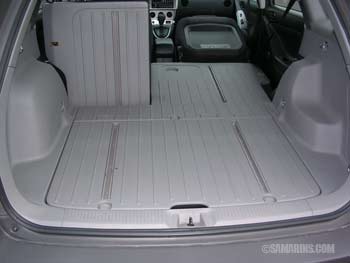 With rear seats folded, the 2003-2008 Pontiac Vibe offers up to 54 cubic feet.
With rear seats folded, the 2003-2008 Pontiac Vibe offers up to 54 cubic feet. Click photo for larger image
The standard engine for the 2009-2010 Vibe is a 132-hp 1.8L DOHC 2ZR-FE Toyota engine, the same as in the Corolla and Matrix. An optional 158-hp 2.4L 4-cylinder 2AZ-FE engine is the same as in the Toyota Camry and RAV4.
Some of the 2.4L engines are known to consume oil. Overall, the 1.8L engine is a better choice in our view, as it's more reliable and can last long with regular oil changes.
Does the Pontiac Vibe have a Timing belt or Timing Chain? All Vibe's engines use a timing chain; there is no timing belt. The timing chain only needs to be replaced if stretched.
Pontiac Vibe Fuel Economy The EPA rates the 2009-2010 1.8L Vibe with an automatic transmission at 26/31 mpg city/highway. The 2003-2008 1.8L Vibe auto gets 25/31 mpg which is equal to 351 miles (565 km) on a full tank of gas. The 2009-2010 Vibe auto with a 2.4L engine is rated at 21/29 mpg city/highway.
Is a Pontiac Vibe a good car to but? The Pontiac Vibe is becoming very rare, offering a sense of uniqueness. The big plus is that the Vibe uses a reliable Toyota engine and other mechanical components that can last long. It's also roomy and good on gas. If you find the Vibe in a good shape and not rusted, it might work as a cheap-on-gas commuter. Even though the Vibe has been discontinued, used parts are widely available.
As of July 2022, Consumer Reports rates the 2003, 2005, 2006 and 2009 Pontiac Vibe 'above average' for reliability. Other model years are not rated. In our opinion, the front-wheel drive 1.8L model is a preferred choice as it will be cheaper to maintain in the long run.
Related reviews:
Honda Civic 2006-2011
Mazda 3 2010-2013
Toyota Matrix 2003-2008
Toyota Matrix 2009-2014
Dodge Dart 2013-2016
Toyota Corolla 1998-2008
Toyota Corolla 2009-2013
Nissan Versa 2007-2011
What to look for when buying a used Pontiac Vibe: Not all Pontiac Vibe modes have anti-lock brakes and this is a must-have option. Given the age, the vehicle needs to be carefully inspected for rust damage underneath, as the brake and fuel lines can be badly corroded. Avoid the car if it looks too rusted.
In all-wheel drive models the center support bearing of a rear drive shaft needs to be checked as it could be worn out. The transmission must be tested in all modes during the test drive. Check if the A/C works. Rear wiper, the stereo (the volume knob) and other electrical features must also be tested. A low oil level is an indication that the engine consumes oil.
